In this project, we will be showing you how to install Seafile on the Raspberry Pi.
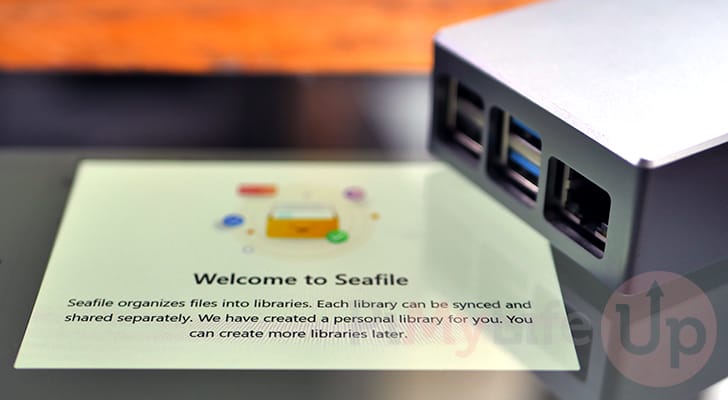
Seafile is an open-source file hosting software that can run on the Raspberry Pi.
This service allows you to have a central place to upload your files. It then allows you to synchronize these files to any other the supported Seafile clients.
One of the advantages of using a file hosting solution such as Seafile is that you retain control of your data. You don’t have to put your trust in a service like Google Drive or Dropbox to respect your privacy.
There are two different versions of Seafile that you can use. One is the free community edition, and the other is the paid enterprise release. In this guide, we will focus purely on the community version.
You can find a comparison between the community and enterprise editions on Seafile’s website.
Seafile is similar to other self-hosted file hosting services you can run on your Raspberry Pi, such as Owncloud and Nextcloud. However, Seafile has more of a focus on being a file hosting service, rather than replicating the experience of Google Drive and Onedrive. If you are just after file hosting, Seafile is definitely the less bloated experience.
Please note you must be running a 64-bit version of Raspberry Pi OS for this guide to work. The Docker image we use for Seafile does not support 32-bit operating systems.
Equipment
Below is a list of the equipment we used while installing Seafile onto the Raspberry Pi.
Recommended
- Raspberry Pi Amazon
- Micro SD Card Amazon
- Power Supply Amazon
- Ethernet Cable Amazon or Wi-Fi Amazon
- External Hard Drive Amazon or USB Drive Amazon
Optional
This tutorial was last tested on a Raspberry Pi 400 running a 64-bit version of Raspberry Pi OS Bookworm.
How to Install Seafile on the Raspberry Pi
Over the following steps, we will be walking you through the process of installing Seafile onto your Raspberry Pi.
To greatly simplify the setup process, we will be utilizing Docker. The advantage of using Docker is that we don’t have to spend ages installing and configuring multiple services.
Additionally, you don’t have to stress about your Seafile setup potentially conflicting with other software you are running on your Pi. Seafile and its dependencies are all kept in their isolated container.
Preparing your Raspberry Pi for Seafile
1. Before we begin, we must update the package list and upgrade any out-of-date packages
You can perform both tasks using the following two commands in the terminal.
sudo apt update
sudo apt upgrade -yCopy2. Once the system finishes updating, you must install Docker on your Raspberry Pi.
The guide we link above walks you through all the steps to installing and configuring Docker on the Pi.
3. After installing Docker, our next step is to create a directory to store our Seafile Docker compose file.
You can create a directory called “seafile” within your home directory by using the following command.
mkdir ~/seafileCopyBy using the tilde (~), we are referring to the current user’s home directory.
4. After creating a directory for Seafile, change into it by running the command below within the terminal.
cd ~/seafileCopyWriting a Docker Compose File
5. We can now begin writing the Docker Compose file that will set up Seafile on our Raspberry Pi.
A compose file is like a set of instructions for Docker to execute. You can begin writing this file by using the command below. We use the nano text editor as it is relatively simple to use.
nano docker-compose.ymlCopy6. Within this file, you will want to add the following lines.
However, while typing in these lines, there are various values that you must replace.
<DBPASSWORD>: The first thing you must set is the database password. Set this to something secure using letters, numbers, and symbols.
You don’t have to remember this value yourself, as it’s used purely within the compose file.<VOLUMEPATH>: Here is where you specify the full path to where you want Seafile to store its data, as well as the files you upload.
You likely want this to be on an external hard drive, as an SD card typically isn’t the best place for storing data.
If you want to try out Seafile without storing data on an external drive, you can use the directory “/opt/seafile-data“.<TIMEZONE>: Your next step is to set the time zone for Seafile to utilize. By default, Seafile will set the timezone to UTC (ETC/UTC).
You can find a list of tz database time zones by going to Wikipedia. The values you need are under the TZ Identifier column.
For example, I live in Hobart, Australia, so I would use “Australia/Hobart” for this value.<ADMINEMAIL>: Next, you must set the email you want to use for your admin account. You will be using this to log in to Seafile on your Raspberry Pi.<ADMINPASSWORD>: The other thing you must do is set a password for your admin account.
You will want to change this within Seafile’s web interface later but still set this to something secure.<ENABLELETSENCRYPT>: If you plan on using HTTPS and have a domain name, you will want to set this value to “true“.
Otherwise, if you aren’t using HTTPS or don’t have a domain name to use, set this to “false“.<HOSTNAME>: Here is where you will specify the domain name you want to use to access your Seafile installation.
If using this locally or without a domain name, you can set this to your local IP address. It is only used if the Letsencrypt option is set to true.
services:
db:
image: mariadb:10.11
container_name: seafile-mysql
environment:
- MYSQL_ROOT_PASSWORD=<strong><DBPASSWORD></strong>
- MYSQL_LOG_CONSOLE=true
volumes:
- /opt/seafile-mysql/db:/var/lib/mysql
networks:
- seafile-net
memcached:
image: memcached:1.6.18
container_name: seafile-memcached
entrypoint: memcached -m 256
networks:
- seafile-net
seafile:
image: seafileltd/seafile-mc:11.0-latest
container_name: seafile
ports:
- "80:80"
# - "443:443" #Remove hashtag if using HTTPS
volumes:
- <strong><VOLUMEPATH></strong>:/shared
environment:
- DB_HOST=db
- DB_ROOT_PASSWD=<strong><DBPASSWORD></strong>
- TIME_ZONE=<strong><TIMEZONE></strong>
- SEAFILE_ADMIN_EMAIL=<strong><ADMINEMAIL></strong>
- SEAFILE_ADMIN_PASSWORD=<strong><ADMINPASSWORD></strong>
- SEAFILE_SERVER_LETSENCRYPT=<strong><ENABLELETSENCRYPT></strong>
- SEAFILE_SERVER_HOSTNAME=<strong><HOSTNAME></strong>
depends_on:
- db
- memcached
networks:
- seafile-net
networks:
seafile-net:CopyPlease note that if you are running other web services on your Raspberry Pi, you may want to change the port Seafile runs on. To do this find “80:80” within this file and change the number on the left-hand side. The value on the left is the port Docker will expose.
For example, if we wanted Seafile to run on port 8080 we would use “8080:80“.
7. After filling out this file, you can now save and quit by pressing CTRL + X, followed by Y, and then the ENTER key.
Starting Seafile on your Raspberry Pi
8. We are finally at the point where we can start Seafile on our Raspberry Pi.
All we need to do is use the following command. This command tells Docker to start the containers specified within the compose file we wrote.
When you first run this command, this process can take a few minutes. It needs to download and set up a container for Seafile, the SQL database, and memcached.
docker compose up -dCopyBy using the “-d” option, we are also telling Docker to detach from the current terminal session. This allows Seafile to continue to run in the background.
Accessing the Seafile Web Interface
9. Now that we have gotten Seafile up and running on your Raspberry Pi, we can access its web interface.
To access this interface, you must know your Pi’s IP address. The easiest way to get this IP is to use the hostname command.
hostname -ICopy10. With your IP address now handy, go to the following address in your web browser.
If you had to change the default port away from the default “80“, you must add it to the end of the URL.
http://<YOURIPADDRESS>11. You will now be greeted with the login screen for Seafile.
Start by typing in the email and password (1.) that you set within the Docker compose file earlier.
After filling out your details, click the “Login” button (2.).
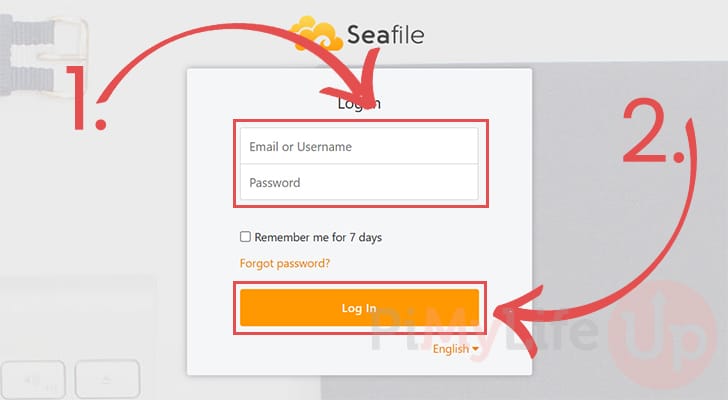
12. You will now see the welcome screen. At this point you have successfully installed Seafile, on your Raspberry Pi. However, there is one task you should complete before using Seafile.
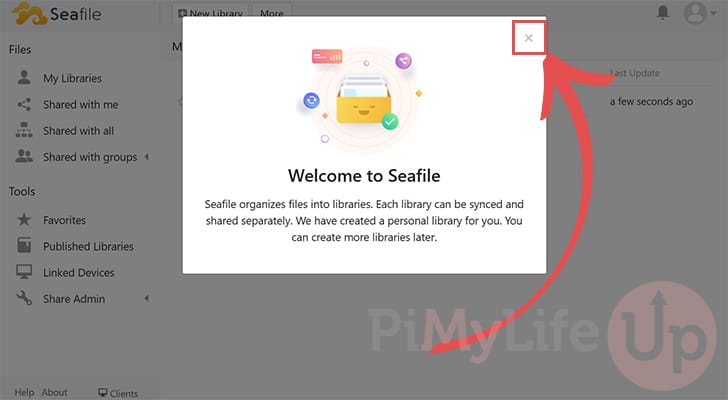
Updating your Password
13. One of the first things you must do is update your password. At the moment, you are using the one that is specified within the Docker compose file, which isn’t the most secure thing to be doing.
To begin this process, click your profile in the top-right corner (1.).
Next, you will want to click the “User Settings” option (2.) in the pop-up menu.
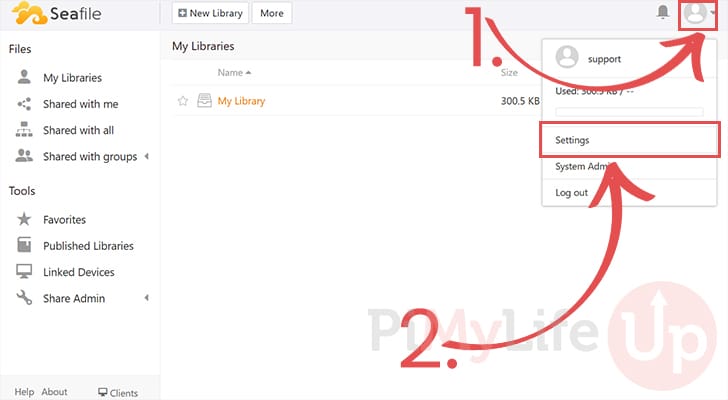
14. Now that you are on the user settings screen, scroll to the “Password” heading and click the “Update” button.
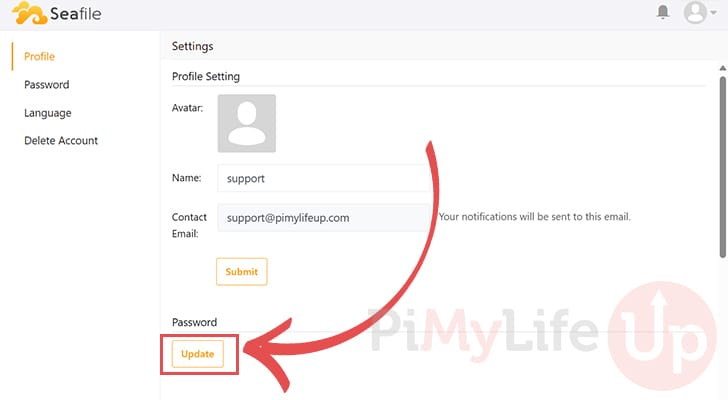
15. You can now set a new password for your admin account for your Raspberry Pi Seafile installation.
First, you must specify the current password for your account (1.).
Next, type in a new password that you will use to log in from now on (2.)
Finally, after completing your details, click the “Submit” button (3.).
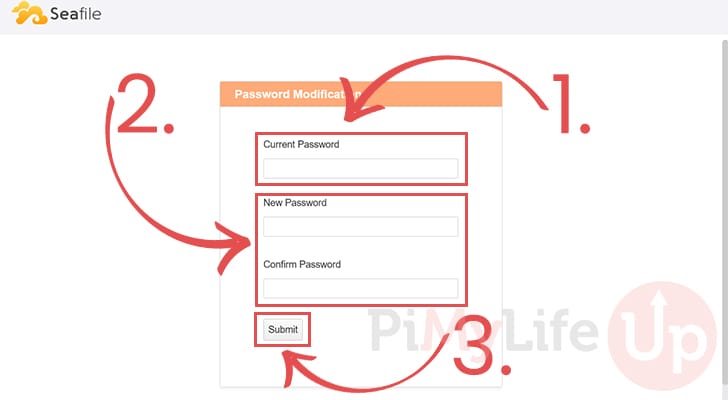
16. At this point, you have successfully updated your password.
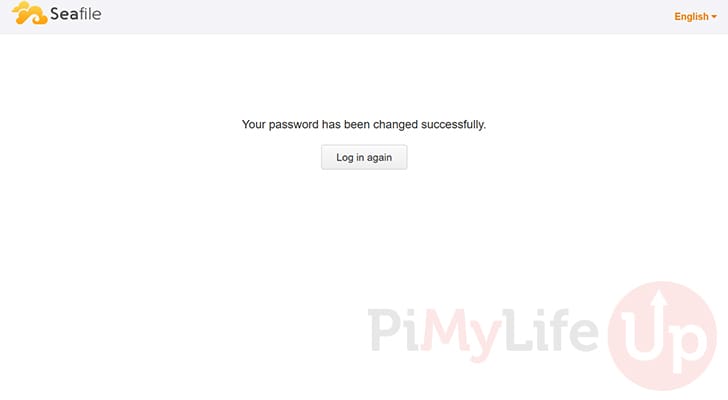
Conclusion
Hopefully, you will have successfully installed Seafile on your Raspberry Pi and got it up and running.
Seafile is a decent self-hosted file hosting solution and an excellent alternative to the heavier Nextcloud and Owncloud solutions.
Please feel free to leave a comment below if you have any questions about installing Seafile on your Raspberry Pi.
If you found this tutorial to be helpful, be sure to check out our many other Raspberry Pi projects.

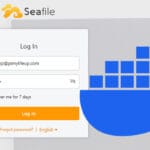



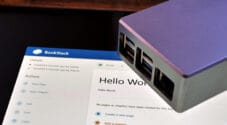




This is a great guide! Thanks! I’m running Open Media Vault (OMV)on my Pi, with the OMV docker plugin. Seafile will not work with it, and I can’t figure it out. I’ve tried previous versions as well as the latest with no luck. I’m thinking it’s a file permissions issues that the OMV docker user is applying that seafile does not like. Thanks again for this amazing guide! I may just buy another pi and run seafile in native docker.
Hi Wil,
My first thought would be that Seafile is using a different user than OpenMediaVault.You would need to work out the UID and GID of your user and then assign them using environemnt varaibles for the Docker container. From memory you should be able to see these values from within the users interface in OMV.
To set Seafile to use a particular user, you would need to add the following option with the UID and GID underneath the Seafile container in the stack.
For example, if our ID was 1000 and GID was 1000 we we would adjust it to look similar to what we have shown below.
Kind regards,
Emmet
Dear Emmet,
Is it possible to show how ssl would be setup with seafile? I am having a terrible time trying to add a nginx docekr into the existing setup and i simply get bad gateway with the https://seafile:443 wher I use an ip for seafile. I looked at the seafile docker manual sections but really i couldnt get any traction
Many thanks!!
Hi Ken,
I would actually suggest using something like Nginx Proxy Manager in front of this if you are in the need for SSL. It makes setting up and routing traffic a lot easier from my own experience.
Kind regards,
Emmet
Thank you once again for an excellent guide.
I discovered that the pro edition is free for home use for up to a maximum of 3 users which is perfect. All I did was register a username and password, in case anyone else is interested in the additional features.
However, what isn’t clear for me is how to install the professional version of the software during the docker installation, could you provide any guidance please?
Many thanks for your time and any additional guidance you may be able to provide
Hi Ken,
Using the pro version does require a few changes to this guide. It doesn’t look like the team distribute the pro version through Docker hub which makes it a little harder to check whether they actually provide ARM versions for the Raspberry Pi.
1. Your first step is to login Docker to Seafile’s Docker repository.
According to their documentation you will find the username and password to login to this repository within their customer center download page.
2. Once logged in you will want to make a change to the Docker Compose file that we have written.
Find the following line within the file.
Replace it with the following
Please let me know if that helps you get the pro version up and running. I haven’t had the chance to test any of this myself.
Kind regards,
Emmet
Hello Emmet,
Thank you very much for your help, I have successfully installed seafile!
I did check their web repository and I didn’t see an ARM version, but I followed your advise by first performing the docker login on the pi cmd terminal.
After that I simply followed the remainder of the instructions to create a directory and a compose.yaml script, populating it with the passwords, email and the PI’s IP address.
The docker up -d command ran without a hitch and I have logged into Seafile which is fantastic, all down to your excellent guide and help with the pro version image query.
As a final question, is there a way for me to check that the pro image was indeed pulled via seafile webpage, just to be sure that it didnt revert to a community edition?
Warm regards
Ken
After completing step 8. I got this answer:
✔ Container seafile-memcached Running 0.0s
✔ Container seafile-mysql Running 0.0s
✔ Container seafile Started 1.6s
Everything seems to be OK, but step 11. doesn’t work! … “Address is invalid”
Hi Wolfgang,
I just re-ran through the tutorial and didn’t run into the same issue.
Please ensure that you have replaced “
<IPADDRESS>” with the IP of your Raspberry Pi. Additionally, ensure that you have no other services running on port 80 as that will cause Seafile to crash during startup unless you have changed the host port away from port 80.Kind regards,
Emmet
I’m getting to Step 8, and it does start the process, but bombs out a couple of seconds in with:
Error response from daemon: manifest for seafileltd/seafile-mc:latest not found: manifest unknown: manifest unknownThe fix for this is to go into the yml file and change the image line to:
image=seafileltd/seafile-mc:11.0-latestHi Colin,
Thanks for a heads up about this issue, I have updated the guide to point to the updated tag for the Seafile container.
Kind regards,
Emmet
Thank you for this! I was looking for a replacement to Nextcloud and your tutorial made it quite easy to follow and set up Seafile as an experimental alternative
You are right, I was confused at first because kernel was 64 bits one but all software in the system is 32 bits, will have to reinstall and see. Cheers!
Step 8 won’t work at least with a raspberry pi 4 I get:
no matching manifest for linux/arm/v8 in the manifest list entries
Hi Daniel,
As mentioned at the start of the tutorial, you must be running a 64-bit version of Raspberry Pi OS.
You can verify this by following our guide that shows you how to check if the OS is 32-bit or 64-bit.
Kind regards,
Emmet